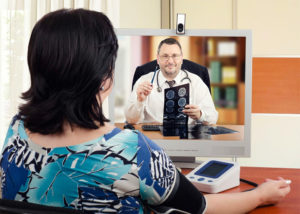Improving Patient Telehealth Experience
Telehealth Assessment
 Gaining access to healthcare has become even more essential than ever. The COVID-19 pandemic didn’t prevent healthcare workers from discharging their oath and tackling medical issues quickly and properly. In fact, the use and popularity of telehealth expanded significantly in response to the COVID-19 pandemic.
Gaining access to healthcare has become even more essential than ever. The COVID-19 pandemic didn’t prevent healthcare workers from discharging their oath and tackling medical issues quickly and properly. In fact, the use and popularity of telehealth expanded significantly in response to the COVID-19 pandemic.
An assessment of telehealth capabilities in 2019 indicated that only 43% of facilities were ready to exploit the power of telehealth. Just a year later, that number soared to 95%. This is a powerful illustration of just how quickly telemedicine services have proven their value to patients and healthcare providers alike.
Truth is, telehealth is not as much a new notion as one might believe. It’s actually been around since the 1960s when the military, in war-ravaged circumstances, required medical support for their ailing soldiers. That said, at the start of COVID-19, telehealth held a value of $50 billion which is predicted to inflate to almost $500 billion by 2030.
Needless to say, telehealth is here to stay.
4 Ways to Improve Telehealth:
- Make certain you have a sturdy internet connection
A stable, constant internet connection is one of the basics of a first-rate telehealth encounter. There’s nothing like a weak internet signal to make a patient assessment plummet. A managed IT service firm can hook you up with a terrific ISP or internet service provider. They recognize which players in the industry are dependable and have a well thought-of background. - Be sure you have a backup connection
If everything else crashes, have an alternative plan at hand. You simply can’t leave a patient dangling on the screen. So, if your principal internet connection isn’t functioning as it should, you need to be able to switch to a backup, which may well be 4G, 5G, LTE or wireless broadband. Sound confusing? Don’t be overly concerned. A knowledgeable IT professional is quite able to make this decision for you. - Use a dependable videoconferencing app
There’s an overabundance of video conferencing apps you can install for your telehealth sessions. True, there are an assortment of free tools out there too, but you have to be sure that you’re making use of an app that’s meant specifically for healthcare.
There are video conferencing apps that are HIPAA and HITECH compliant. Specialized software (like this) can connect patients with medical devices such as digital stethoscopes, patients’ health record and exam cameras. It also accepts more than one participant, so if the patient’s family would want an update with the condition of their family member, they can easily take part. Healthcare providers are also able to split their screen to better educate patients with their findings, etc. - Boost cyber security for your patients’ safety
The medical field is perhaps one on the most susceptible to cyberattacks. Cybercriminals are continually considering methods to penetrate organizations and gain access to confidential information they may well hold hostage for ransom. In 2020, there was a considerable boost in a data breach in the healthcare segment by 42%. Hacking episodes continue to soar, beginning in 2019, ever since the healthcare sector was mostly ill-equipped for the unanticipated onset of COVID-19.
More than 31 million patient records were revealed to hackers, threatening the healthcare provider’s finances and reputation as well as the livelihood of various patients. With that in mind, guarding delicate patient data must be a chief concern as you conduct telehealth with patients. Heightened cybersecurity from a managed IT service firm will provide the security you and your patients require.
There are also any number practical measures that can help make the telehealth visit more successful. Some may well be self-evident, but should still be reviewed when planning a telehealth visit.
To begin, the camera needs to be kept at the provider’s eye level, around two or three feet away. Their face needs to be well lit from the front and backlighting, which can make the provider appear in silhouette, should be prevented. The provider needs to maintain eye contact by looking directly into the camera and explaining anything they’re doing off-camera.
When treating adults via telehealth, the healthcare provider should assess the patient’s surroundings: where they’re calling from, how they appear, what their environs are like and how comfortable they seem. This will help in his/her assessment of the patient’s circumstances. When treating children, it’s recommended to keep toys on hand to make any exam more pleasant. Also, consider seasonal decorations for the provider’s telehealth space, talk to the child directly, encourage them to hold the apparatus the visit is taking place on and acknowledge what the provider is doing off-screen.
Lastly, during a telehealth visit, the provider should make sure they’re in a private space, with a locked door if possible. There should be no interruptions unless it’s an emergency situation.
Conclusion
Patients now benefit from the finest care no matter where they are located, as better access to healthcare is now doable via telehealth. As a result, patient outcomes are now more positive and promising. Gone are the days when the excuse for not visiting the doctor is a consequence of the hardships imposed by travel. Unless a patient requires surgery, they can now be provided critical health assessments with a licensed medical professional by way of telehealth software.
At Medwave we bill for telehealth services, currently assisting many medical providers.

